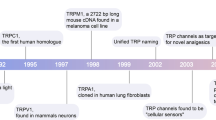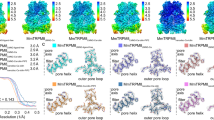Abstract
Menthol is a cooling compound derived from mint leaves and is extensively used as a flavoring chemical. Menthol activates transient receptor potential melastatin 8 (TRPM8), an ion channel also activated by cold, voltage and phosphatidylinositol-4,5-bisphosphate (PIP2). Here we investigated the mechanism by which menthol activates mouse TRPM8. Using a new high-throughput approach, we screened a random mutant library consisting of ∼14,000 individual TRPM8 mutants for clones that are affected in their response to menthol while retaining channel function. We identified determinants of menthol sensitivity in two regions: putative transmembrane segment 2 (S2) and the C-terminal TRP domain. Analysis of these mutants indicated that activation by menthol involves a gating mechanism distinct and separable from gating by cold, voltage or PIP2. Notably, TRP domain mutations mainly attenuated menthol efficacy, suggesting that this domain influences events downstream of initial binding. In contrast, S2 mutations strongly shifted the concentration dependence of menthol activation, raising the possibility that S2 influences menthol binding.
Note: The AOP version of this article was corrected on 19 March 2006. Please see the PDF for details.
This is a preview of subscription content, access via your institution
Access options
Subscribe to this journal
Receive 12 print issues and online access
$209.00 per year
only $17.42 per issue
Buy this article
- Purchase on Springer Link
- Instant access to full article PDF
Prices may be subject to local taxes which are calculated during checkout





Similar content being viewed by others
Change history
19 March 2006
Corrected affiliation for an author
References
Peier, A.M. et al. A TRP channel that senses cold stimuli and menthol. Cell 108, 705–715 (2002).
McKemy, D.D., Neuhausser, W.M. & Julius, D. Identification of a cold receptor reveals a general role for TRP channels in thermosensation. Nature 416, 52–58 (2002).
Bandell, M. et al. Noxious cold ion channel TRPA1 is activated by pungent compounds and bradykinin. Neuron 41, 849–857 (2004).
Jordt, S.E. et al. Mustard oils and cannabinoids excite sensory nerve fibres through the TRP channel ANKTM1. Nature 427, 260–265 (2004).
Moqrich, A. et al. Impaired thermosensation in mice lacking TRPV3, a heat and camphor sensor in the skin. Science 307, 1468–1472 (2005).
Macpherson, L.J. et al. The pungency of garlic: activation of TRPA1 and TRPV1 in response to allicin. Curr. Biol. 15, 929–934 (2005).
Bautista, D.M. et al. Pungent products from garlic activate the sensory ion channel TRPA1. Proc. Natl. Acad. Sci. USA 102, 12248–12252 (2005).
Caterina, M.J. et al. The capsaicin receptor: a heat-activated ion channel in the pain pathway. Nature 389, 816–824 (1997).
Xu, H., Blair, N.T. & Clapham, D.E. Camphor activates and strongly desensitizes the transient receptor potential vanilloid subtype 1 channel in a vanilloid-independent mechanism. J. Neurosci. 25, 8924–8937 (2005).
Liu, B. & Qin, F. Functional control of cold- and menthol-sensitive TRPM8 ion channels by phosphatidylinositol 4,5-bisphosphate. J. Neurosci. 25, 1674–1681 (2005).
Rohacs, T., Lopes, C.M., Michailidis, I. & Logothetis, D.E. PI(4,5)P2 regulates the activation and desensitization of TRPM8 channels through the TRP domain. Nat. Neurosci. 8, 626–634 (2005).
Voets, T. et al. The principle of temperature-dependent gating in cold- and heat-sensitive TRP channels. Nature 430, 748–754 (2004).
Brauchi, S., Orio, P. & Latorre, R. Clues to understanding cold sensation: thermodynamics and electrophysiological analysis of the cold receptor TRPM8. Proc. Natl. Acad. Sci. USA 101, 15494–15499 (2004).
Jordt, S.E. & Julius, D. Molecular basis for species-specific sensitivity to “hot” chili peppers. Cell 108, 421–430 (2002).
Jung, J. et al. Agonist recognition sites in the cytosolic tails of vanilloid receptor 1. J. Biol. Chem. 277, 44448–44454 (2002).
Chuang, H.H., Neuhausser, W.M. & Julius, D. The super-cooling agent icilin reveals a mechanism of coincidence detection by a temperature-sensitive TRP channel. Neuron 43, 859–869 (2004).
Zhang, H., He, C., Yan, X., Mirshahi, T. & Logothetis, D.E. Activation of inwardly rectifying K+ channels by distinct PtdIns(4,5)P2 interactions. Nat. Cell Biol. 1, 183–188 (1999).
Poulos, T.L., Finzel, B.C. & Howard, A.J. High-resolution crystal structure of cytochrome P450cam. J. Mol. Biol. 195, 687–700 (1987).
Nagamine, K. et al. Molecular cloning of a new putative Ca2+ channel protein (TRPC7) highly expressed in brain. Genomics 54, 124–131 (1998).
Varnum, M.D., Black, K.D. & Zagotta, W.N. Molecular mechanism for ligand discrimination of cyclic nucleotide-gated channels. Neuron 15, 619–625 (1995).
Tibbs, G.R., Goulding, E.H. & Siegelbaum, S.A. Allosteric activation and tuning of ligand efficacy in cyclic-nucleotide-gated channels. Nature 386, 612–615 (1997).
Story, G.M. et al. ANKTM1, a TRP-like channel expressed in nociceptive neurons, is activated by cold temperatures. Cell 112, 819–829 (2003).
Behrendt, H.J., Germann, T., Gillen, C., Hatt, H. & Jostock, R. Characterization of the mouse cold-menthol receptor TRPM8 and vanilloid receptor type-1 VR1 using a fluorometric imaging plate reader (FLIPR) assay. Br. J. Pharmacol. 141, 737–745 (2004).
Zhou, L., Olivier, N.B., Yao, H., Young, E.C. & Siegelbaum, S.A. A conserved tripeptide in CNG and HCN channels regulates ligand gating by controlling C-terminal oligomerization. Neuron 44, 823–834 (2004).
Goulding, E.H., Tibbs, G.R. & Siegelbaum, S.A. Molecular mechanism of cyclic-nucleotide-gated channel activation. Nature 372, 369–374 (1994).
Yuan, J.P. et al. Homer binds TRPC family channels and is required for gating of TRPC1 by IP3 receptors. Cell 114, 777–789 (2003).
Garcia-Sanz, N. et al. Identification of a tetramerization domain in the C terminus of the vanilloid receptor. J. Neurosci. 24, 5307–5314 (2004).
Yu, F.H. & Catterall, W.A. The VGL-chanome: a protein superfamily specialized for electrical signaling and ionic homeostasis. Sci. STKE 2004, re15 (2004).
Rosenbaum, T. & Gordon, S.E. Quickening the pace: looking into the heart of HCN channels. Neuron 42, 193–196 (2004).
Kaupp, U.B. & Seifert, R. Cyclic nucleotide-gated ion channels. Physiol. Rev. 82, 769–824 (2002).
Craven, K.B. & Zagotta, W.N. CNG and HCN channels: two peas, one pod. Annu. Rev. Physiol. 68, 375–401 (2006).
Johnson, J.P., Jr. & Zagotta, W.N. Rotational movement during cyclic nucleotide-gated channel opening. Nature 412, 917–921 (2001).
Bhave, G. et al. Protein kinase C phosphorylation sensitizes but does not activate the capsaicin receptor transient receptor potential vanilloid 1 (TRPV1). Proc. Natl. Acad. Sci. USA 100, 12480–12485 (2003).
Wang, T., Jiao, Y. & Montell, C. Dissecting independent channel and scaffolding roles of the Drosophila transient receptor potential channel. J. Cell Biol. 171, 685–694 (2005).
Colquhoun, D. Binding, gating, affinity and efficacy: the interpretation of structure-activity relationships for agonists and of the effects of mutating receptors. Br. J. Pharmacol. 125, 924–947 (1998).
Long, S.B., Campbell, E.B. & Mackinnon, R. Crystal structure of a mammalian voltage-dependent Shaker family K+ channel. Science 309, 897–903 (2005).
Long, S.B., Campbell, E.B. & Mackinnon, R. Voltage sensor of Kv1.2: structural basis of electromechanical coupling. Science 309, 903–908 (2005).
Jiang, Y. et al. X-ray structure of a voltage-dependent K+ channel. Nature 423, 33–41 (2003).
Taylor, J.R. An Introduction to Error Analysis: the Study of Uncertainties in Physical Measurements. (University Science Books, Mill Valley, California, 1982).
Acknowledgements
We thank N. Gray, L. Miraglia, J. Zhang, M. Medina, A. Saghatelian, B. Cravatt, T. Jegla, V. Lee and S. Peters for valuable contributions and input. This work was supported by NINDS grant NS046303. M.B. is supported by a postdoctoral fellowship from the American Heart Association. A.P. is Damon Runyon Fellow and a member of the H. Dorris Neurological Research Institute.
Author information
Authors and Affiliations
Corresponding author
Ethics declarations
Competing interests
The authors declare no competing financial interests.
Supplementary information
Supplementary Fig. 1
Examples of currents generated by cold and menthol in wild type, Y745H and L1009R. (PDF 683 kb)
Supplementary Table 1
Additional mutants for which a >3 fold decrease in menthol/cold response ratio was observed in the secondary screen (see text). (PDF 13 kb)
Rights and permissions
About this article
Cite this article
Bandell, M., Dubin, A., Petrus, M. et al. High-throughput random mutagenesis screen reveals TRPM8 residues specifically required for activation by menthol. Nat Neurosci 9, 493–500 (2006). https://doi.org/10.1038/nn1665
Received:
Accepted:
Published:
Issue Date:
DOI: https://doi.org/10.1038/nn1665
This article is cited by
-
TRP (transient receptor potential) ion channel family: structures, biological functions and therapeutic interventions for diseases
Signal Transduction and Targeted Therapy (2023)
-
TRPV1 inhibition overcomes cisplatin resistance by blocking autophagy-mediated hyperactivation of EGFR signaling pathway
Nature Communications (2023)
-
Targeting natural products against SARS-CoV-2
Environmental Science and Pollution Research (2022)
-
Structural basis for promiscuous action of monoterpenes on TRP channels
Communications Biology (2021)
-
Identification of herbal components as TRPA1 agonists and TRPM8 antagonists
Journal of Natural Medicines (2021)



